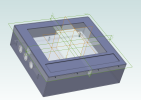Toybuilder
Senior Member
I am working on modeling a control box (see attached image). I have the main box as an assembly, and then there is a top cover assembly which I have started to work on.
When I was a total newbie, I used to just throw a bunch of parts in the top level assembly and often just model in place.
I'm now trying to be more meticulous and methodical. In this design, for example, I have an assembly that represents the main box, and a separate assembly for the top cover.
One of the things I think I need to improve is to set the location and orientation of the reference geometries for new parts (or sub-assys) as I create them.
Right now, I click new-part or new-assy and set that component's name. Then, I go back to the parent assembly that contains this new component and turn on the reference geometry for the new component and will usually use the constraint tool to temporarily "scoot" the component's reference to some feature. When it's just moving along the standard orthogonal directions to mate to a surface, or translating an axis to be concentric to another axis, this is fairly simple. I then delete that constraint, then edit the component to model the part, and then create new constraints based on the actual geometries of mating parts. Is this how you guys do it?
In the example image, I now want to create a part that will be an inlay for the pocket on that front plate. The best I can figure, that would mean I need to first create additional reference geometries in the parent assembly to create an origin centered at the bottom of that pocket. Then, I can follow my usual workflow, I think. This feels all terribly tedious/inefficient and I'm wondering if that's just the way it goes, or if I am being dumb.
I'd love to hear other people's thoughts on this - or referrals to resources where I can learn how to better do this.
Thank you!
When I was a total newbie, I used to just throw a bunch of parts in the top level assembly and often just model in place.
I'm now trying to be more meticulous and methodical. In this design, for example, I have an assembly that represents the main box, and a separate assembly for the top cover.
One of the things I think I need to improve is to set the location and orientation of the reference geometries for new parts (or sub-assys) as I create them.
Right now, I click new-part or new-assy and set that component's name. Then, I go back to the parent assembly that contains this new component and turn on the reference geometry for the new component and will usually use the constraint tool to temporarily "scoot" the component's reference to some feature. When it's just moving along the standard orthogonal directions to mate to a surface, or translating an axis to be concentric to another axis, this is fairly simple. I then delete that constraint, then edit the component to model the part, and then create new constraints based on the actual geometries of mating parts. Is this how you guys do it?
In the example image, I now want to create a part that will be an inlay for the pocket on that front plate. The best I can figure, that would mean I need to first create additional reference geometries in the parent assembly to create an origin centered at the bottom of that pocket. Then, I can follow my usual workflow, I think. This feels all terribly tedious/inefficient and I'm wondering if that's just the way it goes, or if I am being dumb.
I'd love to hear other people's thoughts on this - or referrals to resources where I can learn how to better do this.
Thank you!

